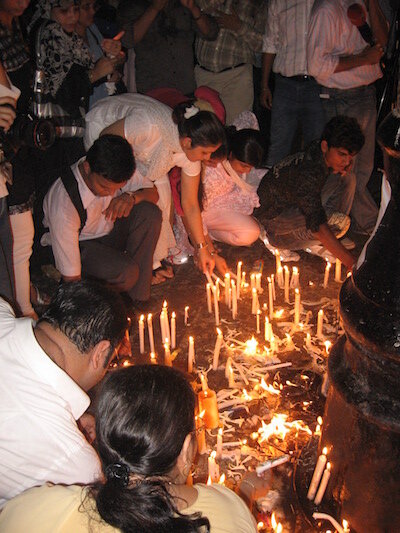TCS Special Section: City-as-Target
Three days ago, almost one and a half years after the terrorist attacks in Mumbai, arrests were still being made in various parts of the world in connection with the attacks. Mumbai, called 'India's 9/11' by US Senator John McCain, is still fresh in public memory.
Image: Candlelight vigils at the Gateway of India, Mumbai. Source: Nicholas (Nichalp) / CC BY-SA 3.0.
In the 'City-as-target' special section of the Theory, Culture & Society Annual Review 2009, Ryan Bishop and Tania Roy, review the issue of urban centres being targets. Mumbai is symbolic but it cannot be seen as a fixed point in the annals of global terrorism. In fact, it cannot be seen as a fixity at all since the urban-centre-under-attack is an ongoing process and one that keeps shifting its locus. As Bishop and Roy comment, the city-as-target is an 'event' (I'm seeing it in a Deleuzian sense) that encompasses the walled cities of the Middle Ages, Hiroshima, as well as the technopolis of today.
The attack on Mumbai, however, brings another set of issues into the forefront: by subverting technology and technicities of the quotidian, it is possible to augment the threat to urban centres. Indeed in a recent documentary on the attacks, the terrorists' control-centre is shown as using the media coverage of the event to provide guidance via cellullar phones to their comrades holed up inside a building and fighting the Indian commandoes. Indeed the same technologies that are mediating a form of temporality to the viewers all over the world are simultaneously responsible for a different temporality for the perpetrators. In such a strand of temporality, the actor and the spectator get conflated and sighting can equate to destruction.
On another level, Bishop and Roy point out that the mediated temporality of Mumbai was also on the television sets and computer screens in Africa where 'the sealed sphere of the globe in solipsistic and self-referential mediated form excluded the continuous and horrific urban onslaught of routinized violence taking place throughout the continent [Africa] and just beyond the TV and computer screens noisily flickering there.'
Mumbai, obviously, is no isolated case and shortly after the Mumbai attacks, another city-as-target was actualised: this time it was Gaza. Very regularly, we hear about events involving cities-as-target. These ‘events' are also reflected in virtual spaces such as those in TV serials like 24 or videogames such as Call of Duty: Modern Warfare 2 : the latter even has a level that resembles the Mumbai terrorist attacks although the location isn't a railway station in Mumbai but an airport in Moscow (in a rather scary way, Moscow has become a target almost days after this post was written). Whether it be in Mumbai or Moscow, the city-as-target is actualised in a multiplicity of spaces and temporalities.
Read: Mumbai: City-as-Target: Introduction. Ryan Bishop and Tania Roy. First Published February 15, 2010, Theory, Culture & Society

